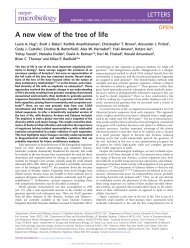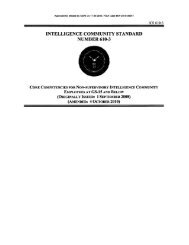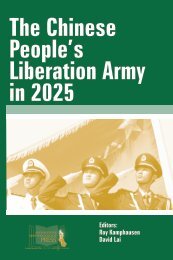The Joint Force in a Contested and Disordered World
JCS-JOE-2035
JCS-JOE-2035
Create successful ePaper yourself
Turn your PDF publications into a flip-book with our unique Google optimized e-Paper software.
Section 3 - Implications for the <strong>Jo<strong>in</strong>t</strong> <strong>Force</strong><br />
“Political leaders th<strong>in</strong>k <strong>in</strong> terms of policies <strong>and</strong> options. Geopolitics teaches us to th<strong>in</strong>k <strong>in</strong><br />
terms of constra<strong>in</strong>ts <strong>and</strong> limits.” 40<br />
<strong>The</strong> United States will face a wide range of emerg<strong>in</strong>g – <strong>and</strong> often unforeseen – challenges <strong>in</strong> the<br />
future security environment featur<strong>in</strong>g both contested norms <strong>and</strong> persistent disorder. Specific U.S.<br />
strategic <strong>and</strong> military objectives to address these challenges will be many, multi-faceted, <strong>and</strong><br />
tailored to a specific time, place, <strong>and</strong> set of circumstances. However, the JOE relies on a range of<br />
strategic goals to describe the overall terms of national commitment <strong>and</strong> articulate an acceptable<br />
end state for any particular U.S. strategic endeavor. <strong>The</strong>se are:<br />
1. Adapt to chang<strong>in</strong>g conditions – ensure the United States can adequately cope with emerg<strong>in</strong>g<br />
changes <strong>in</strong> the security environment.<br />
2. Manage antagonism <strong>and</strong> impose costs – discourage changes to the security environment that<br />
are unfavorable to the United States.<br />
3. Punish aggression <strong>and</strong> rollback ga<strong>in</strong>s – block <strong>and</strong> undo changes to the security environment<br />
that are dangerous or disruptive to the United States.<br />
4. Impose change <strong>and</strong> enforce outcomes – <strong>in</strong>troduce desired changes to the security<br />
environment that are favorable to the United States.<br />
This range of strategic goals suggests differ<strong>in</strong>g levels of engagement, commitment, or overall<br />
posture by the United States. Moreover, this range of goals represents a cont<strong>in</strong>uum <strong>and</strong> may change<br />
over time as a particular situation evolves. At the low end of this cont<strong>in</strong>uum, the United States<br />
might reactively manage security threats or otherwise respond to the consequences of natural <strong>and</strong><br />
humanitarian disasters. At the high end, the United States might proactively solve a security<br />
problem by impos<strong>in</strong>g a U.S. preferred solution that forces an adversary to accede to its will.<br />
<strong>The</strong> role of the <strong>Jo<strong>in</strong>t</strong> <strong>Force</strong> to apply military power to support the achievement of strategic goals<br />
<strong>in</strong> concert with other elements of national power. To effectively pursue this range of goals, the<br />
<strong>Jo<strong>in</strong>t</strong> <strong>Force</strong> conducts four types of endur<strong>in</strong>g military tasks aga<strong>in</strong>st an array of competitors <strong>and</strong> <strong>in</strong><br />
response to a range of phenomena. <strong>The</strong>se are:<br />
1. Shape or conta<strong>in</strong> to assist the United States with cop<strong>in</strong>g <strong>and</strong> adapt<strong>in</strong>g to changed <strong>in</strong>ternational<br />
security conditions.<br />
2. Deter or deny to manage the antagonistic behavior of competitors or to impose costs on<br />
competitors or adversaries tak<strong>in</strong>g aggressive action.<br />
3. Disrupt or degrade to punish aggressive action by an adversary or to force an adversary to<br />
retreat from previous ga<strong>in</strong>s.<br />
4. Compel or destroy to impose desired changes to the <strong>in</strong>ternational security environment <strong>and</strong><br />
subsequently enforce those outcomes.<br />
To appreciate the breadth <strong>and</strong> depth of evolv<strong>in</strong>g military missions, the range of strategic goals <strong>and</strong><br />
their associated military tasks must be exam<strong>in</strong>ed across the Contexts of Future Conflict. <strong>The</strong> set of<br />
40<br />
George Friedman, Geopolitical Journey Part 1, (8 November 2010).<br />
40











